There is something truly exotic when pronouncing "Buenos Aires”. The roll of the words off the tongue would entice the keenest of travellers to explore this region just for it’s name. But the name is not all this city has to offer… who could say no to eclectic architecture, delicious barbecues or chasing waterfalls? What could be more exciting than colourful Rio? Or the magnificent Amazon? Or playing football on a beach in a truly unique part of the world?
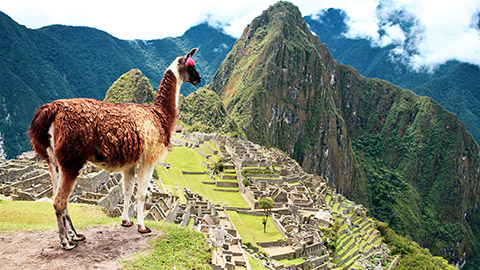
Peru reaches the highest of heights with the Andes and the archeological wonder of Machu Picchu.
Bolivia is authentic; with it’s roots in indigenous history and the aspiration to understand a distinctive way of life.
Spice up in Colombia! Grab a partner and dance your way through the cobble streets. Feel the Caribbean sand between your toes and explore one of the best kept secrets South America has to offer.
Some of the counties that make up South America include:
- Peru
- Brazil
- Chile
- Bolivia
- Argentina
- Ecuador.
Each of these countries have attractions which are commonly visited by tourists.

Peru - a blast from the past
With remote communities providing an opportunity to experience authenticity and see how old ways live on. Submerge yourself, and you'll leave Peru with an experience leaving you with the feeling of time travel.
Located high in the Andes mountains, this Incan city dates back to the 1400’s. It is Peru’s most popular attraction, with tourists hiking for 5 days through the mountains to reach it! For the less adventurous, you can reach it by using a combination of train and bus.
It is known that Machu Picchu was a lost city, however recent discoveries have shed further light on the initial discoveries of explorer Hiram Bingham III.
As he embarked on his endeavour to determine the Lost city of Inca, he was in fact seeking a different city, known as Vilcabamba. This was a hidden capital to which the Inca had escaped after the Spanish conquistadors arrived in 1532. As the time passed, it gained fame as the legendary Lost city of Inca. For a majority of his life, Bingham argued that Vilcabamba and Machu Picchu were one and the same. After his death it was uncovered that they were not the same; Vilcabamba was located west of Machu Picchu. When he discovered Machu Picchu, there were allegedly three families of farmers living there; which proved the city was not lost at all.
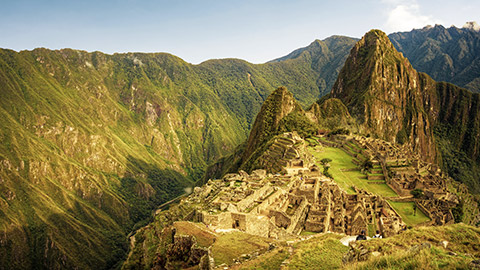
Did you know? (Some INCA-resting facts!)
Machu Picchu is built on two fault lines, meaning it is subjected to earthquakes. The city was constructed without using mortar, and this enabled it to withstand an earthquake by giving the stones flexibility to move during the event. If it were not for this method of building, Machu Picchu would have collapsed long ago.
Seek and you shall find...
Much of Machu Picchu is hidden. This includes a museum and a secret temple.
The museum is tucked at the end of a long dirt road near the base of Machu Picchu, about a 30-minute walk from the town of Aguas Calientes. It provides valuable information about the purpose and construction of Machu Picchu.
The Temple of the Moon is located at the end of a trail on the far side of Huayna Picchu. It is said to be the home of the 'ceremonial shrine' and has been built into a cave lined with stunning stonework and niches that were once probably used to hold mummies.
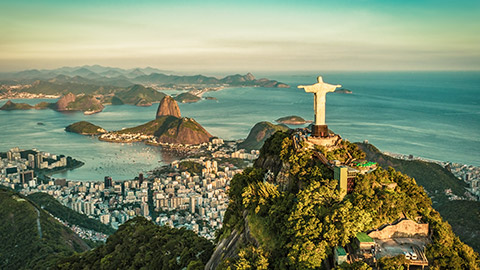
Brazil is the largest country in South America. It is also the 5th largest country in the world in land area and population. This tropical country is also home to the major city of Rio De Janeiro, where the statue of Christ the Redeemer can be located.
For sporting fanatics, Football (soccer) is the most popular sport in Brazil, with the national team consistently among the best in the world. Brazil has won the World Cup a record 5 times!
Christ the Redeemer (Portuguese Cristo Redentor), is a colossal statue of Jesus Christ at the summit of Mount Corcovado, Rio de Janeiro, southeastern Brazil. It was completed in 1931 and stands 30m tall, its horizontally outstretched arms spanning 28m. The statue, made of reinforced concrete clad in a mosaic of thousands of triangular soapstone tiles, sits on a square stone pedestal base about 8m high, which itself is situated on a deck atop the mountain’s summit. The statue is the largest Art Deco-style sculpture in the world and is one of Rio de Janeiro’s most recognizable landmarks.
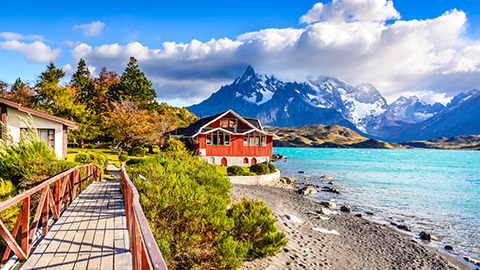
Chile is the longest and narrowest country in the world, stretching over 4,300km (2,670miles).
The Latin American country shares borders with the Pacific Ocean and the South American countries Peru, Bolivia and Argentina. The longest of the borders is shared with Argentina and is 6,691 km/4,157 miles long. Large parts of Chile are covered by mountains.
The most famous landmarks of Chile are the mountain peaks of the Torres del Paine national park and the statues on the Easter Islands. The UNESCO protected national park offers visitors stunning scenery found in Chile. It has mountains, glaciers, volcanoes and forest regions. It is bigger than any of New Zealand’s national parks, and very popular with climbers and hikers.

Bolivia was once part of the ancient Inca empire and has the highest population of indigenous people. Traditions and customs are still widely practised in everyday life and give the country it’s eclectic charm. Authentic experiences can be undertaken by participating in community-based tourism and hiring local guides.
Uyuni Salt Flats
Bolivia is home to the Uyuni Salt Flats. This distinctive environment is made up of 10,582km2 of salt. A shallow covering of water gives you the impression of walking on water over this extra-terrestrial landscape!
While feeling cold may not be appealing to most, it won't be the teeth chattering cold that will leave the lasting memory; it will be the warmth of the hot springs and the barren, iridescent landscape of the salt flat.
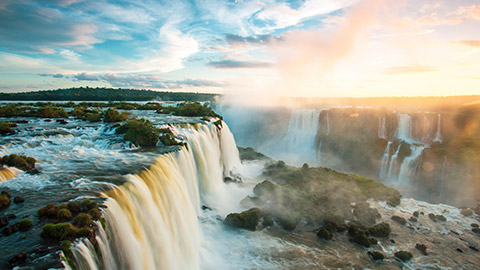
Argentina is bordered by Bolivia, Brazil, Chile, Paraguay and Uruguay.
The capital city of Buenes Aires is also the countries' most populous. It boasts many cafes, restaurants and cultural attrctions. Places to see in Buenos Aires include the la Boca district with its colourful buildings, or the city centre.
Argentina prides itself on a love of football and it's famous sultry dance, the Tango.
Argentina's most spectacular natural attraction is the Iguazu Falls. The U-shaped head of the falls is known as the Devil’s Throat. It is made up of a series of around 275 separate waterfalls. Most of these falls are found on the Argentinian side of the border (the other side is Brazil).
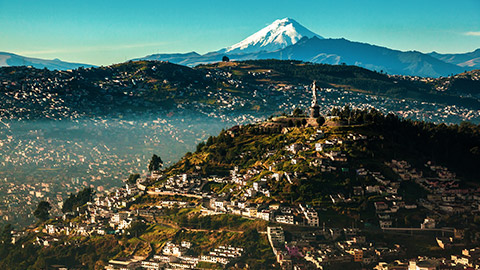
Did you know?
Ecuador means ‘equator’ and is the only country named after a geographical feature.
It is located in northwest South America and is one of three South American countries that straddle the equator.
Ecuador possesses some of the tallest mountains on the South American continent and is home to 2 World Heritage Sites, one of which includes the Galapagos Islands. It is considered the most bio-diverse country in the world.
Defined as a “living museum” it is home to an abundance of animals and birds that cannot be found anywhere else in the world, including the giant tortoise, Iguanas and Galapagos Hawk.
Ecuador’s constitution of 2008 makes the country the most advanced in the world for protecting animal and plant rights.
The Galapagos Islands. This isolated group of 19 islands is protected by UNESCO and owned by Ecuador.
Here is a short video outlining the unique Iguana that inhabits Galapagos.
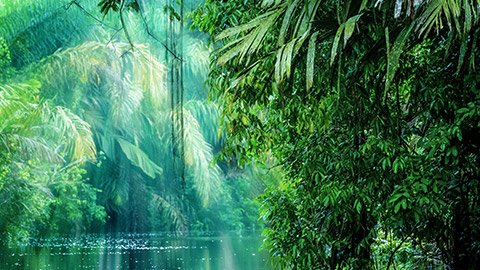
The Amazon Rainforest is considered the lungs of our planet, and plays a significant role in regulating the earth's atmosphere. It spreads across approximately 40% of the whole South American continent.
60% Of the Amazon rainforest is located with in Brazil.
Until recently, many of the jungle communities had little contact with the outside world, and so it is a great opportunity to experience what life was like in simpler times.
Watch the video below and discover some top 10 facts about the Amazon Rainforest
Activity
Answer the following questions about the Tourist Attractions in South America.
References
Lonely Planet, (2020, 13 May) Peru
National Geographic, (2020, 13 May) Top 10 Machu Picchu Secrets National Geographic Society
Science Kids, (2020, 13 May) Brazil Facts for Kids
Chile Facts for Kids, (2020, 13 May) Kids-World-Travel-Guide.com
Torres Del Paine (2020, 13 May)
Lonely Planet,(2020, 13 May) Bolivia
Discover Ecuador, (2020 13 May) Ecuador
YouTube, (2020, 13 May) Galápagos with David Attenborough
YouTube, (2020, 13 May) Earth Titan Top 10 Facts about the Amazon Rainforest
